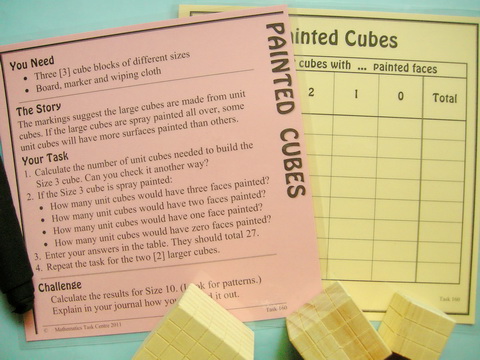
Painted CubesTask 160 ... Years 4 - 12SummaryA cube made from unit cubes is spray painted on all faces, when deconstructed into its unit cubes, how many of these have 3, 2, 1, 0 faces painted. This classic problem is full of pattern and algebra investigations and yet the students don't have to be experienced algebraists to 'get it'. The generalisations may be developed from the tabulated data or they may be developed by visual inspection combined with knowledge of the number of faces, edges and vertices of a cube.This cameo has a From The Classroom section which shows the journal work of a teacher in training challenged to explore a visual representation of the difference between two cubes as a result of exploring Painted Cubes. |
Materials
Content
|

IcebergA task is the tip of a learning iceberg. There is always more to a task than is recorded on the card. |
The opening question may seem a little straight forward, but its intent is to encourage students to see 'into' the scored cube - to deconstruct it. This visual separation of the whole into parts is important in developing the patterns in the main problem. If you have 2cm cubes (or similar) in the room it can be useful to ask students to show you how their calculation methods can be demonstrated. Two ways to calculate are:

Extension
|
Whole Class InvestigationTasks are an invitation for two students to work like a mathematician. Tasks can also be modified to become whole class investigations which model how a mathematician works. |
With enough wooden cubes or linking cubes and students working in groups the task can be converted to a whole class investigation. An advantage of linking cubes is that they can be joined to create just the 12 edges of a cube, thereby encouraging visualisation of the other parts that do and do not receive paint. The information above will guide the lesson. John Hancock, Settlebeck High School, Cumbria, England, led his class on just such an investigation. Cube Tube includes two short videos taken in the first lesson of this investigation. Students recorded in their journals as they explored and when the class had discovered as much as was possible, John challenged them to publish their findings. Becky & Lydia's PowerPoint Report is an example of student publishing from Year 8. This link includes comment by John Hibbs (retired inspector of schools) following a visit to the school. For more ideas and discussion about this investigation, open a new browser tab (or page) and visit Maths300 Lesson 38, Painted Cubes, which includes an Investigation Guide with answers and discussion and four more PowerPoint presentations from classmates of Becky and Lydia. |
Is it in Maths With Attitude?Maths With Attitude is a set of hands-on learning kits available from Years 3-10 which structure the use of tasks and whole class investigations into a week by week planner. |
The Painted Cubes task is an integral part of:
The Painted Cubes lesson is an integral part of:
|
Högskolan Malmö
Shpetim Ademi |
Barbro Söderberg's class of teachers training to teach Gymnasium (Years 10 - 12) explored Painted Cubes. They were challenged to consider that if there is small cube inside a bigger cube then the material between the two must be the difference between the two cubes. They were encouraged to imagine slicing away sections of the outer cube to reveal the inner one and then to try rearranging the slices to create an expression for the difference.
Shpetim's shows how this tweak of Painted Cubes leads to serious high level algebra. (Click the image to reveal a larger version.) |
